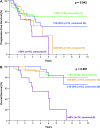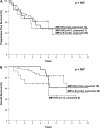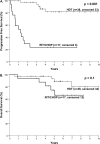Prognostic impact of proliferative index determined by quantitative image analysis and the International Prognostic Index in patients with mantle cell lymphoma
- PMID: 20019090
- PMCID: PMC2795614
- DOI: 10.1093/annonc/mdp495
Prognostic impact of proliferative index determined by quantitative image analysis and the International Prognostic Index in patients with mantle cell lymphoma
Abstract
Background: The proliferative index (PI) is a powerful prognostic factor in mantle cell lymphoma (MCL); however, its utility is hampered by interobserver variability. The mantle cell international prognostic index (MIPI) has been reported to have prognostic importance. In this study, we determined the prognostic value of the PI as determined by quantitative image analysis in MCL.
Patients and methods: Eighty-eight patients with adequate tissue were included in this analysis. Patients were treated with one of two treatment programs: sequential therapy with high-dose therapy consolidation or radioimmunotherapy followed by combination chemotherapy with cyclophosphamide, doxorubicin, vincristine and prednisone. Patients were divided into four groups based on PI (<10%, 10%-29.9%, 30%-49.9%, and >50%), and outcomes were analyzed.
Results: Thirty percent was identified as the optimal cut-off for PI. By univariate analysis, intensive treatment and a low PI were associated with a superior progression-free survival (PFS); only PI was associated with overall survival. By multivariate analysis, both intensive treatment and PI correlated with PFS. The MIPI had no prognostic impact.
Conclusions: PI is the most important prognostic factor in MCL. The cut-off of 30% is clinically meaningful and can be used to tailor the intensity of therapy in future clinical trials.
Figures




References
-
- Zucca E, Roggero E, Pinotti G, et al. Patterns of survival in mantle cell lymphoma. Ann Oncol. 1995;6:257–262. - PubMed
-
- Andersen NS, Jensen MK, de Nully Brown P, Geisler CH. A Danish population-based analysis of 105 mantle cell lymphoma patients: incidences, clinical features, response, survival and prognostic factors. Eur J Cancer. 2002;38:401–408. - PubMed
-
- Herrmann A, Hoster E, Zwingers T, et al. Improvement of overall survival in advanced stage mantle cell lymphoma. J Clin Oncol. 2009;27:511–518. - PubMed
-
- Lenz G, Dreyling M, Hoster E, et al. Immunochemotherapy with rituximab and cyclophosphamide, doxorubicin, vincristine, and prednisone significantly improves response and time to treatment failure, but not long-term outcome in patients with previously untreated mantle cell lymphoma: results of a prospective randomized trial of the German Low Grade Lymphoma Study Group (GLSG) J Clin Oncol. 2005;23:1984–1992. - PubMed
-
- Forstpointner R, Dreyling M, Repp R, et al. The addition of rituximab to a combination of fludarabine, cyclophosphamide, mitoxantrone (FCM) significantly increases the response rate and prolongs survival as compared with FCM alone in patients with relapsed and refractory follicular and mantle cell lymphomas: results of a prospective randomized study of the German Low-Grade Lymphoma Study Group. Blood. 2004;104:3064–3071. - PubMed
Publication types
MeSH terms
Substances
LinkOut - more resources
Full Text Sources
Research Materials
Miscellaneous

